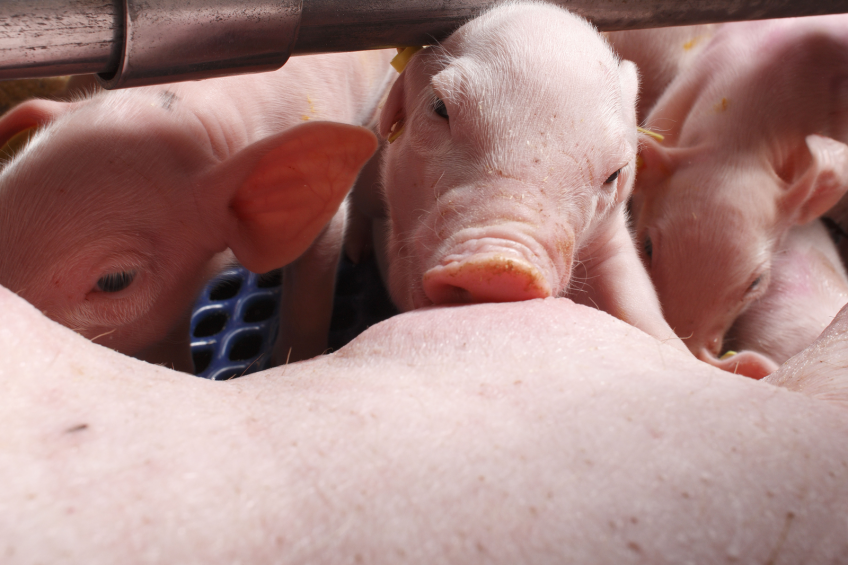Liquid prestarter in diets can ease weaning

Meeting the nutritional requirements of piglets before weaning is a challenge. A new option is to feed a liquid prestarter through an automatic system in each farrowing crate. Trial results show that this can increase feed intakes and improve growth rates.
By Eric van der Hoeven, Provimi
Larger litters have led to lower average birth and weaning weights. In addition, sow milk supply is often not sufficient to support entire litters. Ensuring piglets get adequate intakes of a prestarter, producers can enhance weight gain and litter uniformity. Using dry feed, however, can be very labour intensive as well. These factors led researchers to consider using established automatic milk replacer feeding systems for a liquid prestarter.
Fed before a prestarter, milk replacers can help to improve overall pre-weaning feed intakes. In the past decade there have been advances made in the feed intake characteristics of milk replacers.
Trial results show that feeding a quality milk replacer before introducing a dry prestarter can increase overall pre-weaning feed intake compared to feeding just a dry prestarter.
Achieving high feed intakes pre-weaning will help improve weight gain and lead to healthier litters with lower pre-weaning mortality rates. Furthermore, a high pre-weaning feed intake will help to develop the piglet’s intestines to digest vegetable components. These factors all contribute towards a smooth weaning process.
Pre-weaning feeding
One option is to feed milk replacer through the RescueCup system (Provimi) located in the farrowing pen and next to suckling piglets. Until recently, it had not been possible to feed a prestarter through the same system. This came down to manually delivering a dry feed into each farrowing pen – a labour intensive and costly process.
This explains the philosophy behind the development of a liquid prestarter that could be fed through the RescueCup system. This would allow automatic feeding of a prestarter and, by making the feed more readily available, should increase intakes.
Development work has now been completed on a liquid prestarter matching these requirements.
The prestarter feed is a white powder with free-flowing properties that dissolves easily in water. Trials at the Cargill Innovation Center, the Netherlands, have shown that the liquid prestarter can achieve higher pre-weaning feed intakes, reduce labour requirements associated with feeding a prestarter and achieve faster growth rates with lower mortality compared with feeding a dry prestarter only.
Litters were fed milk replacer from day 2 to day 14, after which the liquid prestarter followed from day 14 until weaning. Both milk replacer and liquid prestarter were fed through the RescueCup automatic feeding system. Results were measured and compared with a control group fed dry prestarter.
Figure 1 shows the cumulative feed intake of feeding a milk replacer and a liquid prestarter compared with feeding a dry prestarter only.
The increased intakes achieved indicate that the combination of these liquid feeds improves intestinal development and enhances the transition from pre- to post-weaning.
In the trial work the higher feed intakes achieved pre-weaning lead to heavier piglets at weaning. Figure 2 shows that suckling piglets fed milk replacer and liquid prestarter were more than 500 g heavier at weaning and nearly 2 kg heavier at 74 days compared to piglets that got dry prestarter.
Labour-saving system
Feeding a milk replacer and liquid prestarter through one automatic feeding system saves time. In the case of the trial, RescueCups were placed in each farrowing crate and the milk replaced then the prestarter pumped from a storage bin. The nipples in the cups enable sufficient supply of milk for the young piglets, yet avoid an oversupply and any problems of milk spoilage. In addition, the nipple prevents backflow of milk.
A large advantage of having cups, as standard in every farrowing crate, is that all piglets get enough milk – either sow milk or replacer – and have an ad lib supply of prestarter. This is up to two days pre-weaning when it is recommended to move piglets on to a dry feed that is continued post-weaning. Where wet feeding is used post-weaning the liquid prestarter can be fed until weaning.
All in all, this method helps to smoothen the transition through weaning and improve piglet performance.
PP











